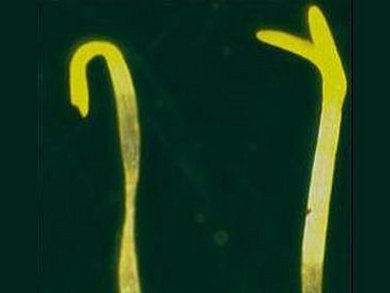Sunlight does not only supply plants with energy, but also controls their development steps. Photoreceptors activate the processes of germination, leaf development, bud formation, and blossoming in the cells.
Tilman Lamparter, Karlsruhe Institute of Technology (KIT), Germany, and colleagues from Japan replaced the light-absorbing component of a photoreceptor, the phytochromobilin, by a chemically similar synthetic substance. They described for the first time the effects on complete plants.
The seeds and seedlings of thale cress were fed with the synthetic substance 15Ea-phycocyanobilin. Incorporation of 15Ea-PCB activates the photoreceptor and the plant is made believe it is exposed to light. In spite of the darkness, model plants germinate and grow similar to a control group exposed to light. The plants developed in the dark as if they were in light.
These findings are of high use for agricultural industry in the cultivation of flowers or biomass production, for instance.
Synthetic photoreceptors might be valuable tools for research, as they facilitate studies of many chemical plant processes compared to conventional genetic engineering methods. Apart from growth, photosynthesis can also be investigated much better.
Image: Seedling on the right was fed with a synthetic photoreceptor and opens it
cotyledons. In the dark control (left seedling), they remain closed. © T. Lamparter, KIT
- Assembly of Synthetic Locked Phycocyanobilin Derivatives with Phytochrome in Vitro and in Vivo in Ceratodon purpureus and Arabidopsis,
Rui Yanga, Kaori Nishiyamab, Ayumi Kamiyab, Yutaka Ukajib, Katsuhiko Inomata, Tilman Lamparter,
The Plant Cell 2012.
DOI: 10.1105/tpc.111.094656



